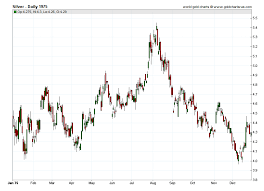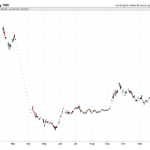In 1975, silver prices experienced significant fluctuations, with the highest recorded price at $5.21 per ounce on August 11th and the lowest at $3.93 per ounce on December 10th. This historical data provides insight into the factors that affect silver prices and the trends that have shaped the market over time. Understanding these fluctuations and trends can be useful for investors, traders, and anyone interested in the precious metals market.
Silver is a valuable commodity that has been used for thousands of years for its aesthetic and industrial properties. As a result, it has become an important part of the global economy, with prices influenced by a range of factors such as supply and demand, economic conditions, and geopolitical events.
By examining the fluctuations and trends of silver prices in 1975, we can gain a better understanding of how these factors have impacted the market in the past and potentially predict future price movements.
Overview
The overview of silver prices, including its fluctuations and trends, provides valuable insight into the market conditions and can aid in making informed investment decisions based on historical data.
Market analysis of silver prices can help investors understand the factors that influence the price of silver, such as supply and demand, geopolitical events, and economic conditions.
By analyzing historical data, investors can identify patterns and trends that may help predict future price movements and make informed investment decisions.
The historical significance of silver prices cannot be overstated, as silver has been used as a store of value for thousands of years.
In modern times, silver has played an important role in the global economy as an industrial metal, with a wide range of applications in electronics, solar panels, and medical equipment.
The value of silver is influenced by a complex set of factors, many of which are beyond the control of any individual investor.
By carefully analyzing market trends and historical data, investors can gain a better understanding of the silver market and make informed decisions about their investments.
Factors Affecting Prices
One key determinant of the value of silver is the interplay between supply and demand, which can be influenced by a variety of economic and geopolitical factors. For example, when the demand for silver exceeds the supply, the price of silver tends to rise. Conversely, when the supply of silver exceeds the demand, the price of silver tends to fall. The supply and demand dynamics of silver are influenced by a range of factors such as production levels, technological advancements, and industrial demand.
Geopolitical events can also have a significant impact on the price of silver. For instance, political instability, trade tensions, and economic sanctions can disrupt the supply chain of silver, leading to supply shortages and higher prices. Similarly, global economic conditions such as inflation, currency fluctuations, and interest rates can also affect the demand for silver and, consequently, its price. As such, investors and traders need to keep a close eye on both economic and geopolitical developments to make informed decisions about investing in silver.
| Factors Affecting Silver Prices | Description | Example | ||
|---|---|---|---|---|
| Production Levels | The amount of silver produced can affect the supply of silver. | A decrease in silver production due to mine closures. | ||
| Industrial Demand | The demand for silver from industries such as electronics, solar panels, and medical equipment can impact the price of silver. | An increase in demand for silver for the production of solar panels. | ||
| Political Instability | Political unrest and conflicts can disrupt the supply chain of silver, leading to supply shortages and higher prices. | Sanctions imposed on a major silver-producing country. | ||
| Global Economic Conditions | Economic factors such as inflation, currency fluctuations, and interest rates can affect the demand for silver. | A rise in inflation leading to increased demand for silver as a store of value. | ||
| Trade Tensions | Trade disputes between countries can impact the supply and demand of silver. | Tariffs imposed on silver imports leading to a decrease in supply and higher prices. | On the other hand, a resolution to trade tensions can lead to increased trade and demand for silver in industries such as electronics and solar panels. |
Investment Opportunities
Investors and traders can explore potential investment opportunities in the silver market by examining the various economic and geopolitical factors that affect the supply and demand dynamics of this valuable commodity.
Silver has been used as a store of value for centuries and continues to be sought after by investors looking for a hedge against inflation and economic uncertainty. In addition, silver has a wide range of industrial applications, including in electronics, solar panels, and medical equipment, which can increase demand and drive up prices.
Investing in silver can provide long term gains but also carries risks that should be managed carefully. One approach to risk management is to diversify a portfolio, which can help mitigate any losses from fluctuations in the silver market. Another strategy is to take a long-term view of the market, as silver prices can be volatile in the short term but tend to appreciate over time.
Ultimately, investors should conduct thorough research and consult with financial professionals before making any investment decisions in the silver market.
Frequently Asked Questions
What were the primary factors driving the fluctuations in silver prices in 1975?
Investor speculation and industrial demand were the primary factors driving the fluctuations in silver prices in 1975. The market responded to changes in supply and demand, causing prices to fluctuate throughout the year.
How did the silver market compare to other precious metal markets during this time period?
Investor strategies in the precious metals market during the 1975 period were influenced by price comparisons between silver, gold, and platinum. While silver prices fluctuated throughout the year, they generally remained lower than the prices of the other two metals, leading some investors to allocate their funds towards gold and platinum.
Were there any significant geopolitical events that impacted silver prices in 1975?
Various impactful events and government policies affected the silver market in 1975, leading to fluctuations in prices. The US government’s decision to sell off silver reserves and restrictions on silver imports from China contributed to these changes.
How did the average investor participate in the silver market during this time period?
Investor strategies for participating in the silver market in 1975 included purchasing physical bullion or investing in silver-related stocks. Market accessibility varied, with some investors using futures contracts or participating in over-the-counter markets.
What were some of the most notable silver mining companies during 1975?
Top performing silver mines in 1975 included Sunshine Mining Company, Hecla Mining Company, and Coeur d’Alene Mines Corporation. Labor strikes in some mines impacted production levels, leading to fluctuations in supply and prices.





